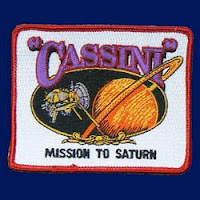NASA - Cassini Mission to Saturn patch.
Nov. 2, 2015
Saturn's frigid moon Titan has some characteristics that are oddly similar to Earth, but still slightly alien. It has clouds, rain and lakes (made of methane and ethane), a solid surface (made of water ice), and vast dune fields (filled with hydrocarbon sands).
The dark, H-shaped area seen here contains two of the dune-filled regions, Fensal (in the north) and Aztlan (to the south).
Cassini's cameras have frequently monitored the surface of Titan (3200 miles or 5150 kilometers across) to look for changes in its features over the course of the mission. Any changes would help scientists better understand different phenomena like winds and dune formation on this strangely earth-like moon.
For a closer view of Fensal-Aztlan, see PIA07732: http://photojournal.jpl.nasa.gov/catalog/PIA07732
This view looks toward the leading side of Titan. North on Titan is up. The image was taken with the Cassini spacecraft narrow-angle camera on July 25, 2015 using a spectral filter sensitive to wavelengths of near-infrared light centered at 938 nanometers.
The view was obtained at a distance of approximately 450,000 miles (730,000 kilometers) from Titan and at a Sun-Titan-spacecraft, or phase, angle of 32 degrees. Image scale is 3 miles (4 kilometers) per pixel.
Artist's view of Titan flyby of the Cassini spacecraft
The Cassini mission is a cooperative project of NASA, ESA (the European Space Agency) and the Italian Space Agency. The Jet Propulsion Laboratory, a division of the California Institute of Technology in Pasadena, manages the mission for NASA's Science Mission Directorate, Washington. The Cassini orbiter and its two onboard cameras were designed, developed and assembled at JPL. The imaging operations center is based at the Space Science Institute in Boulder, Colorado.
For more information about the Cassini-Huygens mission visit http://saturn.jpl.nasa.gov or http://www.nasa.gov/cassini . The Cassini imaging team homepage is at http://ciclops.org and http://www.esa.int/Our_Activities/Space_Science/Cassini-Huygens
Images, Text, Credits: NASA/JPL-Caltech/Space Science Institute/Tony Greicius.
Best regards, Orbiter.ch



